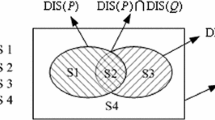Abstract
Radar anti-jamming performance evaluation is a necessary link in the process of radar development, introduction and equipment. The applications of generalized rough set theory are proposed and discussed in this paper to address the problems of big data, incomplete data and redundant data in the construction of evaluation index system. Firstly, a mass of real-valued data is converted to some interval-valued data to avoid an unacceptable number of equivalence classes and classification rules, and the interval similarity relation is employed to make classifications of this interval-valued data. Meanwhile, incomplete data can be solved by a new definition of the connection degree tolerance relation for both interval-valued data and single-valued data, which makes a better description of rough set than the traditional limited tolerance relation. Then, E-condition entropy-based heuristic algorithm is applied to making attribute reduction to optimize the evaluation index system, and final decision rules can be extracted for system evaluation. Finally, the feasibility and advantage of the proposed methods are testified by a real example of radar anti-jamming performance evaluation.
Similar content being viewed by others
References
REN M Q, CAI J Y, ZHU Y Q, et al. Evaluation approach for radar ECCM capability based on RSANFIS [J]. Systems Engineering Theory & Practice, 2013, 33(10): 2701–2709 (in Chinese).
LIU X D. Research of evaluation index system and evaluation method for radar anti-jamming performance [D]. Chengdu, China: School of Optoelectronic Information, University of Electronic Science and Technology of China, 2008 (in Chinese).
PAWLAK Z. Rough sets [J]. International Journal of Computer and Information Sciences, 1982, 11(5): 341–356.
LIANG J Y, QIAN Y H. Information granules and entropy theory in information systems [J]. Science in China Series F: Information Sciences, 2008, 51(10): 1427–1444.
YAO Y Y. On generalizing rough set theory [C]//Rough Sets, Fuzzy Sets, Data Mining, and Granular Computing. Berlin, Germany: Springer-Verlag, 2003: 44–51.
WANG G Y, YU H, YANG D C. Decision table reduction based on conditional information entropy [J]. Chinese Journal of Computer, 2002, 25(7): 1–8 (in Chinese).
TENG S H, ZHOU S L, SUN J X, et al. Attribute reduction algorithm based on conditional entropy under incomplete information system [J]. Journal of National University of Defense Technology of China, 2010, 39(1): 90–94 (in Chinese).
LIANG J Y, CHIN K S, DANG C Y, et al. A new method for measuring uncertainty and fuzziness in rough set theory [J]. International Journal of General Systems, 2002, 31(4): 331–342.
LEUNG Y, FISCHER M M, WUW Z, et al. A rough set approach for the discovery of classification rules in interval-valued information systems [J]. International Journal of Approximate Reasoning, 2008, 47(2): 233–246
KRYSZKIEWICZ M. Rough set approach to incomplete information systems [J]. Information Sciences, 1998, 112(1/2/3/4): 39–49.
STEFANOWSKI J, TSOUKIÀS A. On the extension of rough sets under incomplete information [C]//New Directions in Rough Sets, Data Mining, and Granular Soft Computing. Berlin, Germany: Springer-Verlag, 1999: 73–81.
STEFANOWSKI J, TSOUKIÀS A. Incomplete information tables and rough classification [J]. Computational Intelligence, 2001, 17(3): 545–566.
WANG G Y. Extension of rough set under incomplete information systems [J]. Journal of Computer Research and Development, 2002, 39(10): 1238–1243 (in Chinese).
HUANG B, LI H X, ZHOU X Z. Knowledge reduction for incomplete connection-degree-based rough sets model [J]. Computer Engineering, 2008, 34(11): 18–20 (in Chinese).
ZENG L, HE P Y, FU M. Attribute reduction algorithm based on rough set in incomplete interval-valued information system [J]. Journal of Nanjing University of Science and Technology, 2013, 37(4): 524–529 (in Chinese).
Author information
Authors and Affiliations
Corresponding author
Additional information
Foundation item: the Opening Project of the State Key Laboratory of Complex Electromagnetic Environment Effects on Electronics and Information System (No. CEMEE2014K0301A)
Rights and permissions
About this article
Cite this article
Qi, Z., Han, S. & Li, J. Applications of generalized rough set theory in evaluation index system of radar anti-jamming performance. J. Shanghai Jiaotong Univ. (Sci.) 21, 151–158 (2016). https://doi.org/10.1007/s12204-016-1706-3
Received:
Published:
Issue Date:
DOI: https://doi.org/10.1007/s12204-016-1706-3
Keywords
- generalized rough set
- evaluation index system
- big data solution
- incomplete data solution
- redundant data solution




